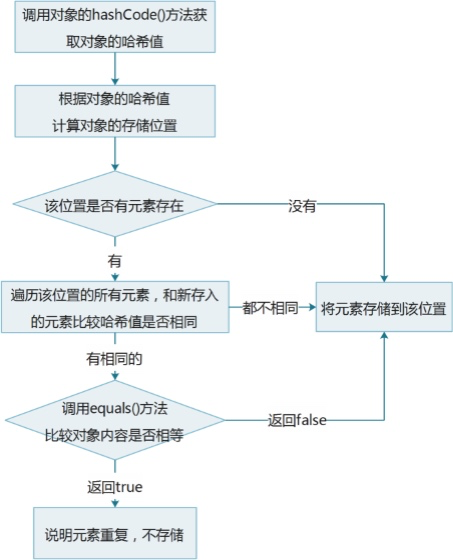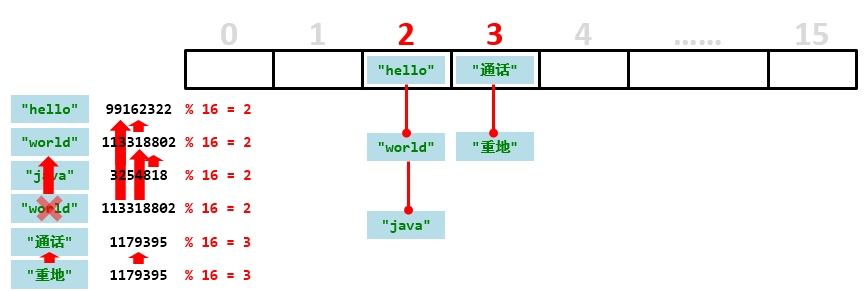0x00 概述
本文涉及Java知识点有Set集合,HashSet,LinkedHashSet,TreeSet,比较器Comparator,泛型,可变参数。
0x01 Set集合
1.1 Set集合概述和特点
- Set集合的特点
元素存取无序
没有索引,只能通过迭代器或者增强for循环遍历
不能存储重复元素
- Set结合的基本使用
package SetDemo; import java.util.HashSet; import java.util.Set; public class SetDemo { public static void main(String[] args) { // 创建结合对象 Set<String> set = new HashSet<String>(); // 添加元素 set.add("hello"); set.add("world"); set.add("java"); // 不能包含重复的元素 set.add("world"); // 遍历 for (String s : set) { System.out.println(s); } } }
1.2 哈希值
- 哈希值简介
是JDK根据对象的地址或者字符串或者数字算出来的int类型的数值
- 如何获取哈希值
Object类中的public int hashCode(): 返回对象的哈希码值
- 哈希值的特点
同一个对象多次调用hashCode()方法返回的哈希值时相同的
默认情况下,不同对象的哈希值是不同的,而重写hashCode()方法,可以实现让不同对象的哈希值相同
- 获取哈希值的代码示例
package HashDemo1; public class Student { private String name; private int age; public Student() { } public Student(String name, int age) { this.name = name; this.age = age; } public String getName() { return name; } public void setName(String name) { this.name = name; } public int getAge() { return age; } public void setAge(int age) { this.age = age; } @Override public int hashCode() { return 0; } }
package HashDemo1; public class HashDemo { public static void main(String[] args) { // 创建学生对象 Student s1 = new Student("Alice", 30); // 同一个对象多次调用hashCode()方法返回的哈希值是相同的(未重写hashCode方法) System.out.println(s1.hashCode()); // 460141958 System.out.println(s1.hashCode()); // 460141958 System.out.println("---------"); Student s2 = new Student("Bob", 23); // 默认情况下,不同对象的哈希值是不相同的 // 通过方法重写,可以实现不同对象的哈希值是相同的 System.out.println(s2.hashCode()); // 1163157884 System.out.println("---------"); System.out.println("hello".hashCode()); // 99162322 System.out.println("world".hashCode()); // 113318802 System.out.println("java".hashCode()); // 3254818 System.out.println("world".hashCode()); // 113318802 System.out.println("---------"); System.out.println("重地".hashCode()); System.out.println("通话".hashCode()); } }
1.3 HashSet集合概述和特点
- HashSet集合的特点
底层数据结构是哈希表
对集合的迭代顺序不作任何保证,也就是说不保证存储和取出的元素顺序一致
没有带索引的方法,所以不能使用普通for循环遍历
由于是Set集合,所以是不包含重复元素的集合
- HashSet集合的基本使用
package HashSetDemo; import java.util.HashSet; public class HashSetDemo1 { public static void main(String[] args) { // 创建集合对象 HashSet<String> hs = new HashSet<String>(); // 添加元素 hs.add("hello"); hs.add("world"); hs.add("java"); hs.add("world"); // 遍历 for (String s : hs) { System.out.println(s); } } }
1.4 HashSet集合保证元素唯一性源码分析
- HashSet集合保证元素唯一性的原理
1. 根据对象的哈希值计算存储位置
如果当前位置没有元素则直接存入
如果当前位置有元素存在,则进入第二步
2. 当前元素的元素和已经存在的元素比较哈希值
如果哈希值不同,则将当前元素进行存储
如果哈希值相同,则进入第三步
3. 通过equals()方法比较两个元素的内容
如果内容不相同,则将当前元素进行存储
如果内容相同,则不存储当前元素
- HashSet集合保证元素唯一性的图解

1.5 常见数据结构之哈希表

1.6 HashSet集合存储学生对象并遍历
需求:创建一个存储学生对象的集合,存储多个学生对象,使用程序实现在控制台遍历该集合
示例:
package HashSetDemo2; import java.util.Objects; public class Student { private String name; private int age; public Student() { } public Student(String name, int age) { this.name = name; this.age = age; } public String getName() { return name; } public void setName(String name) { this.name = name; } public int getAge() { return age; } public void setAge(int age) { this.age = age; } @Override public boolean equals(Object o) { if (this == o) return true; if (o == null || getClass() != o.getClass()) return false; Student student = (Student) o; return age == student.age && Objects.equals(name, student.name); } @Override public int hashCode() { int result = name != null ? name.hashCode() : 0; result = 31 * result + age; return result; } }
package HashSetDemo2; import java.util.HashSet; public class HashSetDemo2 { public static void main(String[] args) { // 创建HashSet集合对象 HashSet<Student> hs = new HashSet<Student>(); // 创建学生 Student s1 = new Student("Alice", 30); Student s2 = new Student("Bob", 35); Student s3 = new Student("Charlie", 24); Student s4 = new Student("Charlie", 24); // 把学生添加到集合 hs.add(s1); hs.add(s2); hs.add(s3); hs.add(s4); // 遍历集合(增强for) for (Student s : hs) { System.out.println(s.getName() + ", " + s.getAge()); } } }
1.7 LinkedHashSet集合概述和特点
- LinkedHashSet集合特点
哈希表和链表实现的Set接口,具体有可预测的迭代次序
由链表保证元素有序,也就是说元素的存储和缺处顺序是一致的
由哈希表保证元素唯一,也就是说没有重复的元素
- LinkedHashSet集合基本使用
package LinkedHashSet1; import java.util.LinkedHashSet; public class LinkedHashSetDemo { public static void main(String[] args) { // 创建对象 LinkedHashSet<String> lhs = new LinkedHashSet<String>(); // 添加元素 lhs.add("hello"); lhs.add("world"); lhs.add("java"); lhs.add("world"); // 遍历集合 for (String s : lhs) { System.out.println(s); } } }
0x02 Set集合排序
2.1 TreeSet集合概述和特点
- TreeSet集合概述
元素有序,可以按照一定的规则进行排序,具体排序方式取决于构造方法
TreeSet():根据其元素的自然排序进行排序
TreeSet(Comparator comparator):根据指定的比较器进行排序
没有带索引的方法,所以不能使用普通for循环遍历
由于是Set集合,所以不包含重复元素的集合
- TreeSet集合基本使用
package TreeSetDemo1; import java.util.TreeSet; public class TreeSetDemo1 { public static void main(String[] args) { // 创建集合对象 TreeSet<Integer> ts = new TreeSet<Integer>(); // 添加元素 ts.add(10); ts.add(40); ts.add(30); ts.add(50); ts.add(20); ts.add(30); // 遍历集合 for(Integer i : ts) { System.out.println(i); } } }
2.2 自然排序Comparable的使用
- 需求:
存储学生对象并遍历,创建TreeSet集合使用无参构造方法
要求:按照年龄从小到大排序,年龄相同时,按照姓名和字母顺序排序
- 实现步骤:
用TreeSet集合存储自定义对象,无参构造方法使用的是自然排序对元素进行排序
自然排序,就是让元素所属的类实现Comparator接口,重写compareTo(T o)方法
重写方法时,一定要注意排序规则必须按照要求的主要条件和次要条件来写
- 示例
package TreeSetDemo2; import java.util.TreeSet; public class TreeSetDemo2 { public static void main(String[] args) { // 创建集合对象 TreeSet<Student> ts = new TreeSet<Student>(); // 创建学生对象 Student s1 = new Student("xishi", 29); Student s2 = new Student("wangzhaojun", 28); Student s3 = new Student("diaochan", 30); Student s4 = new Student("yangyuhuan", 33); Student s5 = new Student("linqingxia", 33); Student s6 = new Student("linqingxia", 33); // 添加学生到集合 ts.add(s1); ts.add(s2); ts.add(s3); ts.add(s4); ts.add(s5); ts.add(s6); // 遍历集合 for (Student s : ts) { System.out.println(s.getName() + "," + s.getAge()); } } }
2.3 比较器排序Comparator的使用
- 需求:
存储学生对象并遍历,创建TreeSet集合使用带参构造的方法
要求:按照年龄从小到大排序,年龄相同时,按照姓名的字母顺序排序
- 实现步骤:
用TreeSet集合存储自定义对象,带参构造方法使用的是比较器排序对元素进行排序
比较器排序,就是让集合构造方法接收Comparator的实现类对象,重写compare(T o1, T o2)方法
重写方法时,一定要注意排序规则必须按照要求的主要条件和次要条件来写
示例
package TreeSetDemo3; public class Student { private String name; private int age; public Student() { } public Student(String name, int age) { this.name = name; this.age = age; } public String getName() { return name; } public void setName(String name) { this.name = name; } public int getAge() { return age; } public void setAge(int age) { this.age = age; } }
package TreeSetDemo3; import java.util.Comparator; import java.util.TreeSet; public class TreeSetDemo3 { public static void main(String[] args) { // 创建集合对象 TreeSet<Student> ts = new TreeSet<Student>(new Comparator<Student>() { @Override public int compare(Student o1, Student o2) { // return 0; // this.age - s.age // s1, s2 int num = o1.getAge() - o2.getAge(); int num2 = num == 0 ? o1.getName().compareTo(o2.getName()) : num; return num2; } }); // 创建学生对象 Student s1 = new Student("xishi", 29); Student s2 = new Student("wangzhaojun", 28); Student s3 = new Student("diaochan", 30); Student s4 = new Student("yangyuhuan", 33); Student s5 = new Student("linqingxia", 33); Student s6 = new Student("linqingxia", 33); // 把学生添加到集合 ts.add(s1); ts.add(s2); ts.add(s3); ts.add(s4); ts.add(s5); ts.add(s6); // 遍历集合 for (Student s : ts) { } System.out.println(s1.getName() + "" + s1.getAge()); } }
2.4 成绩排序案例
- 需求:
用TreeSet集合存储多个学生信息,姓名,语文成绩,数学成绩,并遍历该集合
要求:按照总分从高到低出现
示例
package TreeSetDemo4; public class Student { private String name; private int chinese; private int math; public Student() { } public Student(String name, int chinese, int math) { this.name = name; this.chinese = chinese; this.math = math; } public String getName() { return name; } public void setName(String name) { this.name = name; } public int getChinese() { return chinese; } public void setChinese(int chinese) { this.chinese = chinese; } public int getMath() { return math; } public void setMath(int math) { this.math = math; } // 计算总分 public int getSum() { return this.chinese + this.math; } }
package TreeSetDemo4; import java.util.Comparator; import java.util.TreeSet; public class TreeSetDemo4 { public static void main(String[] args) { // 创建TreeSet集合对象,通过比较器排序进行排序 TreeSet<Student> ts = new TreeSet<Student>(new Comparator<Student>() { @Override public int compare(Student o1, Student o2) { // return 0; // int num = (o2.getChinese()+o2.getMath()) - (o1.getChinese()+o1.getMath()); // 主要条件 int num = o2.getSum() - o1.getSum(); // 次要条件 int num2 = num == 0 ? o1.getChinese() - o1.getChinese() : num; int num3 = num2 == 0 ? o1.getMath() - o1.getMath() : num2; return num3; } }); // 创建学生对象 Student s1 = new Student("Alice", 98, 100); Student s2 = new Student("Bob", 95, 95); Student s3 = new Student("Charlie", 100, 93); Student s4 = new Student("Delta", 100, 97); Student s5 = new Student("Echo", 98, 98); Student s6 = new Student("Fox", 97, 99); Student s7 = new Student("Harry", 97, 99); // 把学生添加到结合 ts.add(s1); ts.add(s2); ts.add(s3); ts.add(s4); ts.add(s5); ts.add(s6); ts.add(s7); // 遍历集合 for (Student s : ts) { System.out.println(s.getName() + ", " + s.getChinese() + ", " + s.getMath() + ", " + s.getSum()); } } }
2.5 不重复的随机数案例
需求:编写一个程序,获取10个1-20之间的随机数,要求随机数不能重复,并在控制台输出
示例
package SetDemo2; import java.util.HashSet; import java.util.Random; import java.util.Set; import java.util.TreeSet; public class SetDemo { public static void main(String[] args) { // 创建Set集合对象 // Set<Integer> set = new HashSet<Integer>(); Set<Integer> set = new TreeSet<Integer>(); // 创建随机数 Random r = new Random(); // 判断集合的长度是不是小于10 while (set.size() < 10) { // 产生一个随机数,添加到集合 int number = r.nextInt(20) + 1; set.add(number); } // 遍历集合 for (Integer i : set) { System.out.println(i); } } }
0x03 泛型
3.1 泛型概述和好处
- 泛型概述
是JDK5中引入的特性,它提供了编译时类型安全检测机制,该机制允许在编译时检测到非法的类型
它的本质是参数化类型,也就是说所操作的数据类型被指定为一个参数,一提到参数,最熟悉的就是定义方法时有形参,然后调用此方法时传递实参。
那么参数化类型怎么理解呢?顾名思义,就是将类型由原来的具体的类型参数化,然后在使用或者调用时传入具体的类型。这种参数类型可以用在类,方法和接口中,
分别被称为泛型类,泛型方法,泛型接口
- 泛型定义格式
<类型> :指定一种类型的格式,这里的类型可以看成是形参
<类型1,类型2>:指定多种类型的格式,多种类型之间用逗号隔开,这里的类型可以看成是形参
将来具体调用的时候给定的类型可以看成是实参,并且实参的类型只能是引用数据类型
- 泛型的好处
把运行时期的问题提前到了编译期间
避免了强制类型转换
3.2 泛型类
定义格式
修饰符 class 类名<类型> { }
示例
public class Generic<T> { private T t; public T getT() { return t; } public void setT(T t) { this.t =t; } }
3.3 泛型方法
定义格式
修饰符 <类型> 返回值类型 方法名(类型 变量名) { }
示例
- 带有泛型方法的类
public class Generic { public <T> void show(T t) { System.out.println(t); } }
- 测试类
public class GenericDemo { public static void main(String[] args) { Generic g = new Generic(); g.show("Alice"); g.show(30); g.show(true); g.show(12.34); } }
3.4 泛型接口
定义格式
修饰符 interface 接口名<类型> { }
示例
- 泛型接口
修饰符 interface 接口名<类型> { }
- 泛型接口实现类
public calss GenericImpl<T> implements Generic<T> { @Override public void show(T t) { System.out.println(t); } }
- 测试类
public class GenericDemo { public static void main(String[] args) { Generic<String> g1 = new GenericImpl<String>(); g1.show("Alice"); Generic<Integer> g2 = new GenericImpl<Integer0>(); g2.show(30); } }
3.5 类型通配符
- 类型通配符的作用
为了表示各种泛型List的父类,可以使用类型通配符
- 类型通配符的分类
类型通配符:<?>
List<?> : 表示元素类型未知的List,它的元素可以匹配任何的类型
这种带通配符的List仅表示它是各种泛型List的父类,并不能吧元素添加到其中
类型通配符上限: <? extends 类型>
List<? extends Number>: 它表示的类型是Number或者其子类型
类型通配符下限:<? super 类型>
List<? super Number> : 它表示的类型是Number或者其父类型
类型通配符的基本使用
package GenericDemo1; import com.sun.org.apache.xerces.internal.xs.datatypes.ObjectList; import java.lang.reflect.Array; import java.util.ArrayList; import java.util.List; public class GenericDemo { public static void main(String[] args) { // 类行通配符: <?> List<?> list1 = new ArrayList<Object>(); List<?> list2 = new ArrayList<Number>(); List<?> list3 = new ArrayList<Integer>(); System.out.println("------------"); // 类型通配符上限: <? extends> // List<? extends Number> list4 = new ArrayList<Object>(); List<? extends Number> list5 = new ArrayList<Number>(); List<? extends Number> list6 = new ArrayList<Integer>(); System.out.println("-------------"); // 类型通配符下限: <? super 类型> List<? super Number> list7 = new ArrayList<Object>(); List<? super Number> list8 = new ArrayList<Number>(); // List<? super Number> list9 = new ArrayList<Integer>(); } }
0x04 可变参数
4.1 可变参数
- 可变参数介绍
可变参数又称参数个数可变,用作方法的形参出现,那么方法参数个数就是可变的了
- 可变参数定义格式
修饰符 返回值类型 方法名(数据类型... 变量名) { }
- 可变参数的注意事项
这里的变量其实是一个数组
如果一个方法有多个参数,包含可变参数,可变参数要放在最后
- 可变参数的基本使用
package ArgsDemo1; public class ArgsDemo1 { public static void main(String[] args) { System.out.println(sum(10, 20)); System.out.println(sum(10, 20,30)); System.out.println(sum(10, 20,30,40)); System.out.println(sum(10, 20,30,40,50)); System.out.println(sum(10, 20,30,40,50,60)); System.out.println(sum(10, 20,30,40,50,60,70)); System.out.println(sum(10, 20,30,40,50,60,70,80,90,100)); } public static int sum(int... a) { int sum = 0; for (int i : a) { sum += i; } return sum; } }
4.2 可变参数的使用
- Arrays工具类中有一个静态方法:
public static List asList(T...a): 返回由指定数组支持的固定大小的列表
返回的集合不能做增删操作,可以做修改操作
- List接口中有个静态方法
public static List of(E...elements): 返回一个包含任意数量元素的不可变列表
返回的集合不能做增删改操作
- Set接口中有一个静态方法:
public static Set of(E...elements): 返回一个包含任意数量元素的不可变集合
在给元素的时候,不能给重复的元素
返回的集合不能做增删改操作,没有修改方法
示例
package ArgsDemo2; import java.util.Arrays; import java.util.List; import java.util.Set; public class ArgsDemo2 { public static void main(String[] args) { // public static <T> List<T> asList(T...a): 返回由指定数组支持的固定大小的列表 List<String> list = Arrays.asList("hello", "world", "java"); /* list.add("javaee"); // java.lang.UnsupportedOperationException list.remove("java"); // java.lang.UnsupportedOperationException */ list.set(1, "python"); System.out.println(list); System.out.println("------------"); // public static <E> List<E> of(E...elements): 返回包含任意数量元素的不可变列表 List<String> list2 = List.of("hello", "world", "java", "world"); /* list2.add("javaee"); // java.lang.UnsupportedOperationException list2.remove("world"); // java.lang.UnsupportedOperationException list2.set(1,"javaee"); // java.lang.UnsupportedOperationException */ System.out.println(list2); System.out.println("------------"); // public static <E> Set<E> of(E...elements): 返回一个包含任意数量元素的不可变集合 // Set<String> set = Set.of("hello", "world","java","world"); // IllegalArgumentException Set<String> set = Set.of("hello", "world","java"); /* set.add("javaee"); // java.lang.UnsupportedOperationException set.remove("world"); // java.lang.UnsupportedOperationException */ System.out.println(set); System.out.println("------------"); } }